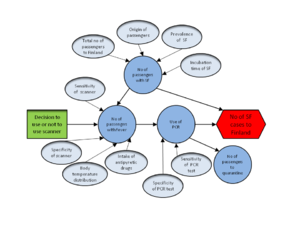Health impacts of urban heat island mitigation in Europe
| [show] |
|---|
This assessment aims to quantify health impacts of heat exposure in large European cities and the effectiveness of different urban heat island mitigation policies in reducing these effects. It is a part of the Intarese Common Case Study.
Scope
Purpose
What are the current and future annual health impacts of heat exposure in large European cities? What is the potential and relative effectiveness of different urban heat island mitigation measures in reducing these impacts?
Boundaries
- Year: 2010, 2020, 2030, 2050
- Geographical area: EU-27, excluding Bulgaria, Cyprus, Latvia, Romania
- North-continental region: Belgium, Germany, Denmark, Estonia, Finland, France, Hungary, Ireland, Lithuania, Luxemburg, Netherlands, Austria, Poland, Slovakia, Czech Republic, United Kingdom, Sweden
- Mediterranean region: Greece, Italy, Malta, Portugal, Slovenia, Spain
- Health impacts:
- Natural mortality
- Cardiovascular mortality
- Respiratory mortality
Scenarios
Future climate scenarios:
- IPCC A1B
- IPCC B1
Intended users
- Intarese Common Case Study
- Anyone interested
Participants
- The National Institute for Health and Welfare (THL), Finland
- University of Stuttgart
Definition
Upload a causal diagram and change the right name here.

Decision variables
- Options to mitigate urban heat island effect
- 1) Business-as-usual (BAU)
- No new UHI mitigation measures
- 2) Increasing urban forestry
- Trees are planted on open areas and street curbsides
- 10.8% of the total urban area is redeveloped from open grass to trees (open area planting)
- 6.7% of the total urban area is redeveloped from street to trees (curbside planting)
- 3) Increasing urban albedo
- Impervious roof and street surfaces are replaced by light colored surfaces
- 13.6% of the total urban area is redeveloped from impervious roof surface to light roof surface
- 34.4% of the total urban area is redeveloped from impervious street surface to light street surface
- 4) Increasing urban forestry and albedo
- 10.8% of the total urban area is redeveloped from open grass to trees (open area planting)
- 6.7% of the total urban area is redeveloped from street to trees (curbside planting)
- 13.6% of the total urban area is redeveloped from impervious roof surface to light roof surface
- 34.4% of the total urban area is redeveloped from impervious street surface to light street surface
- 1) Business-as-usual (BAU)
The fraction of the total urban area in large European cities available to be redeveloped from one land use or surface cover type to another is based on an urban heat island mitigation study conducted in New York City [1]
Indicators
Other variables
- Ambient air temperature in Europe
- Effect of urban land use change on ambient air temperature
- Heat exposure in Europe
- Population of Europe
- Mortality in Europe
- ERF of ambient temperature on mortality
- Following WP3.7-work and WP4.3-screening, DRF will be based on the PHEWE project, which investigated the acute health effects of weather in 15 European cities and provided both pooled estimates (Mediterranean region and North-Continental region) of the impact of heat on mortality (Michelozzi et al. 2007; Baccini et al. 2008). DRFs are based on a linear threshold model. Heat exposure is defined as follows: °C Daily maximum Apparent Temperature over threshold temperature, warm season (April-September).
- Assumption: Threshold and the DRF differ for the Mediterranean region and the North-continental region; we therefore assume that the EU-27 can be divided into two larger regions with different DRF.
- Assumption: Temperatures above thresholds will only occur in warm season (April-September)
- Assumption: DRF for mortality due to natural causes can be applied to total mortality
Analyses
Qualitative and quantitative uncertainty analyses